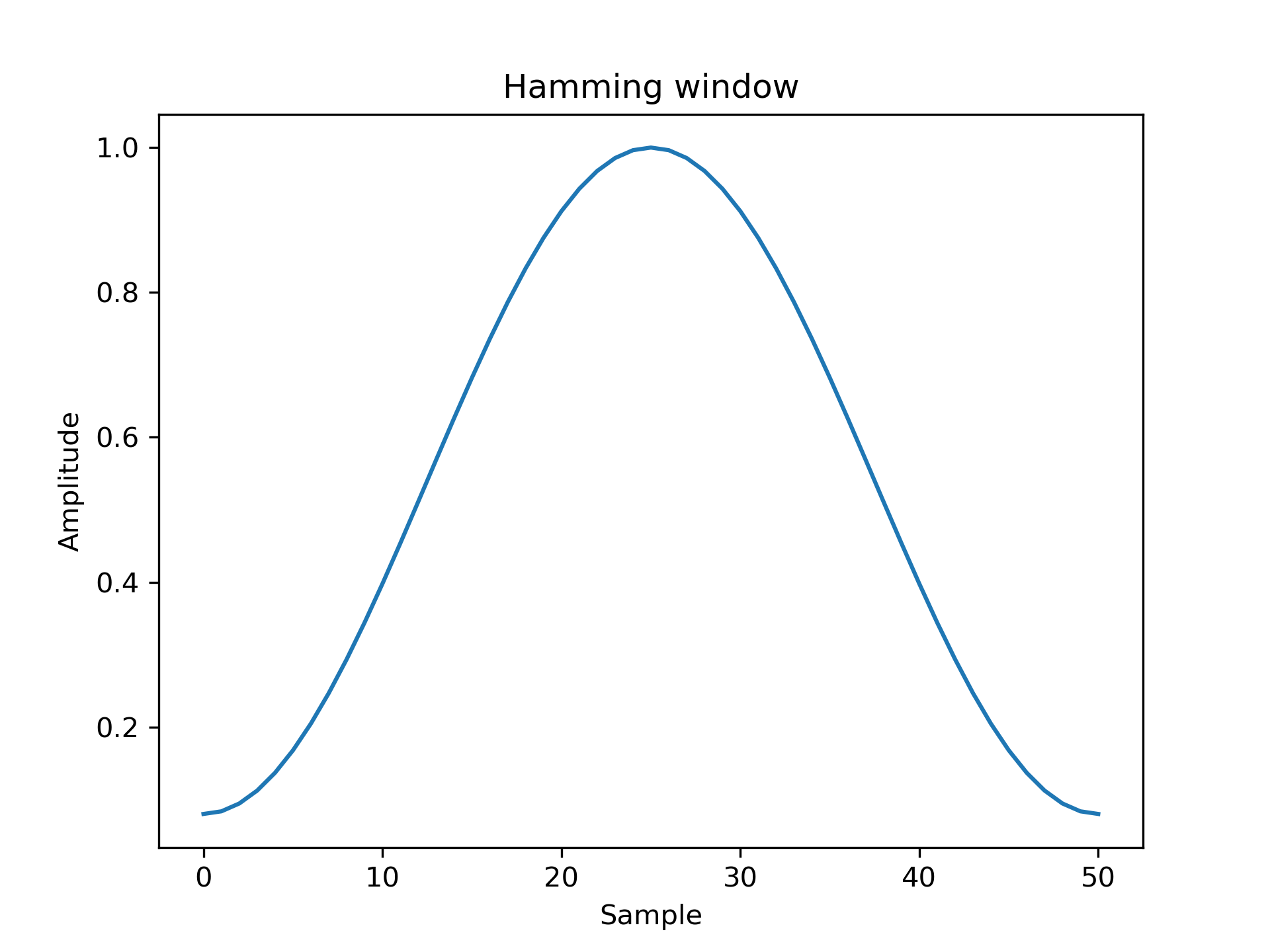hamming(M)
The Hamming window is a taper formed by using a weighted cosine.
The Hamming window is defined as
$$w(n) = 0.54 - 0.46cos\left(\frac{2\pi{n}}{M-1}\right)\qquad 0 \leq n \leq M-1$$The Hamming was named for R. W. Hamming, an associate of J. W. Tukey and is described in Blackman and Tukey. It was recommended for smoothing the truncated autocovariance function in the time domain. Most references to the Hamming window come from the signal processing literature, where it is used as one of many windowing functions for smoothing values. It is also known as an apodization (which means "removing the foot", i.e. smoothing discontinuities at the beginning and end of the sampled signal) or tapering function.
Number of points in the output window. If zero or less, an empty array is returned.
The window, with the maximum value normalized to one (the value one appears only if the number of samples is odd).
Return the Hamming window.
>>> np.hamming(12) array([ 0.08 , 0.15302337, 0.34890909, 0.60546483, 0.84123594, # may vary 0.98136677, 0.98136677, 0.84123594, 0.60546483, 0.34890909, 0.15302337, 0.08 ])
Plot the window and the frequency response:
>>> import matplotlib.pyplot as plt
... from numpy.fft import fft, fftshift
... window = np.hamming(51)
... plt.plot(window) [<matplotlib.lines.Line2D object at 0x...>]
>>> plt.title("Hamming window") Text(0.5, 1.0, 'Hamming window')
>>> plt.ylabel("Amplitude") Text(0, 0.5, 'Amplitude')
>>> plt.xlabel("Sample") Text(0.5, 0, 'Sample')
>>> plt.show()

>>> plt.figure() <Figure size 640x480 with 0 Axes>
>>> A = fft(window, 2048) / 25.5
... mag = np.abs(fftshift(A))
... freq = np.linspace(-0.5, 0.5, len(A))
... response = 20 * np.log10(mag)
... response = np.clip(response, -100, 100)
... plt.plot(freq, response) [<matplotlib.lines.Line2D object at 0x...>]
>>> plt.title("Frequency response of Hamming window") Text(0.5, 1.0, 'Frequency response of Hamming window')
>>> plt.ylabel("Magnitude [dB]") Text(0, 0.5, 'Magnitude [dB]')
>>> plt.xlabel("Normalized frequency [cycles per sample]") Text(0.5, 0, 'Normalized frequency [cycles per sample]')
>>> plt.axis('tight') ...
>>> plt.show()

The following pages refer to to this document either explicitly or contain code examples using this.
matplotlib.axes._axes.Axes.cohere
matplotlib.pyplot.psd
numpy.kaiser
matplotlib.pyplot.angle_spectrum
matplotlib.axes._axes.Axes.magnitude_spectrum
numpy.bartlett
matplotlib.pyplot.cohere
numpy.hanning
matplotlib.mlab.cohere
matplotlib.mlab.specgram
numpy.blackman
matplotlib.pyplot.magnitude_spectrum
matplotlib.axes._axes.Axes.psd
matplotlib.pyplot.phase_spectrum
matplotlib.pyplot.csd
matplotlib.axes._axes.Axes.csd
matplotlib.mlab.csd
matplotlib.axes._axes.Axes.angle_spectrum
matplotlib.axes._axes.Axes.phase_spectrum
matplotlib.pyplot.specgram
matplotlib.axes._axes.Axes.specgram
matplotlib.mlab.psd
Hover to see nodes names; edges to Self not shown, Caped at 50 nodes.
Using a canvas is more power efficient and can get hundred of nodes ; but does not allow hyperlinks; , arrows or text (beyond on hover)
SVG is more flexible but power hungry; and does not scale well to 50 + nodes.
All aboves nodes referred to, (or are referred from) current nodes; Edges from Self to other have been omitted (or all nodes would be connected to the central node "self" which is not useful). Nodes are colored by the library they belong to, and scaled with the number of references pointing them